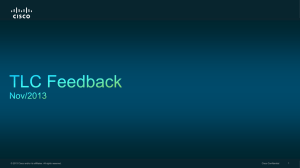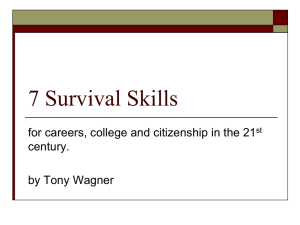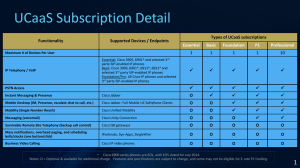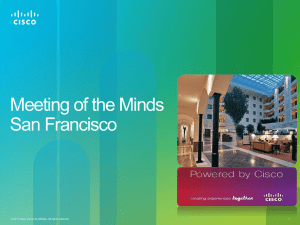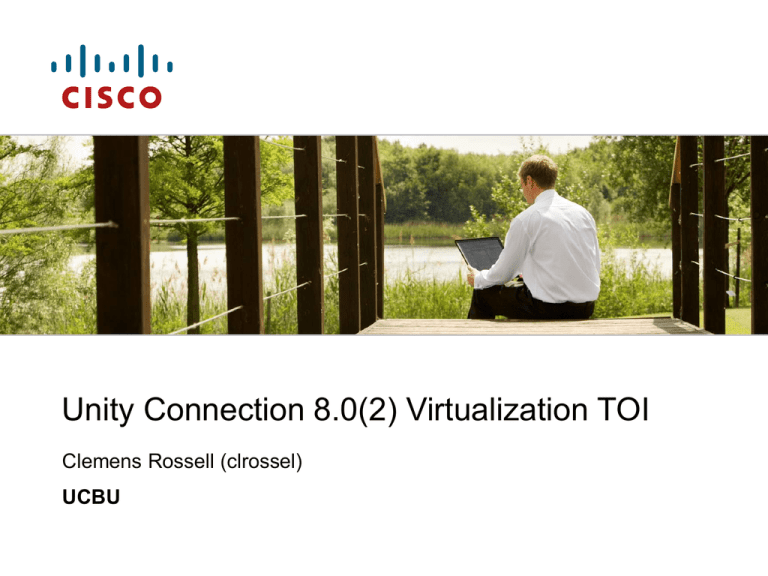
Unity Connection 8.0(2) Virtualization TOI
Clemens Rossell (clrossel)
UCBU
Disclaimer
Some things you should know first:
This TOI does not cover virtualization basics
For a very high level overview of virtualization refer
to the following Skyhook TOI from Jim Bryant:
http://wwwineng.cisco.com/Eng/VTG/IPCBU/Presentations/skyhookvirtualization-tac-toi.pptx
Presentation_ID
© 2010 Cisco and/or its affiliates. All rights reserved.
Cisco Confidential
2
TOI Objectives
What should you know by the end of the TOI?
What is Cisco’s ideal target customer for
virtualization?
Unity Connection installation requirements
How should the virtual machine be configured?
Connection OVA templates: (1) what are they & (2)
why should customers use them?
Connection scalability in a virtual environment
VOS licensing model for virtualization & impact
Physical to Virtual (P2V) Migration Process
Presentation_ID
© 2010 Cisco and/or its affiliates. All rights reserved.
Cisco Confidential
3
Customer Expectations
Our ideal customer is:
Very knowledgeable of virtualization, not a newbie
Maintains an existing virtual infrastructure:
Existing Fibre-Channel SAN storage
Existing VMware vCenter Server
Existing VMware hosts
Does not need hand holding (from Cisco) on
VMware infrastructure maintenance & operations
Typically 2,500 subscriber base
Presentation_ID
© 2010 Cisco and/or its affiliates. All rights reserved.
Cisco Confidential
4
Installation Requirements
What does a customer need to know?
Cisco Unified Computing System hardware only
Fibre-Channel SAN storage
VMware ESX-i 4 Update 1 or higher
ESX4 is not supported, it lowers performance
All VMware features, except for VMware High
Availability (HA), not supported for initial release
Do not oversubscribe host CPU & memory
At least one NTP server accessible to Connection
Connection 8.0(2) or higher (see P2V migration)
Presentation_ID
© 2010 Cisco and/or its affiliates. All rights reserved.
Cisco Confidential
5
Virtual Machine Configuration
How should a customer configure the CUC VM?
One of the following minimums must be met
2 vCPU + 4GB RAM + One 200GB vDisk
4 vCPU + 4GB RAM + Two 146GB vDisks
RAM & storage may be increased beyond
minimums, for example:
4 vCPU + 8GB RAM + Two 300GB vDisks
Do not oversubscribe host CPU & memory
Virtual Machine Hardware 7 or higher
Presentation_ID
© 2010 Cisco and/or its affiliates. All rights reserved.
Cisco Confidential
6
Virtual Machine Configuration (cont.)
How should a customer configure the CUC VM?
vDisks configured as Independent Persistent
Independent persistent mode provides the best
storage performance, important for a real-time app
Disks not affected by snapshots (not supported
anyway)
Presentation_ID
© 2010 Cisco and/or its affiliates. All rights reserved.
Cisco Confidential
7
Connection VMware OVA Templates
What are they?
Two templates providing the following overlays:
2 vCPU + 4GB RAM + One 200GB vDisk
4 vCPU + 4GB RAM + Two 146GB vDisks
An OVA template is VMware’s way of rubber
stamping VMs, all settings deployed to new VM
Provides starting point if customer wishes to make
additional customization, e.g increased RAM or
storage resources assigned to VM
SAN alignment: the virtual disks have been already
aligned @ 64K boundaries, improved IOPS vs.
creating a VM from scratch
Presentation_ID
© 2010 Cisco and/or its affiliates. All rights reserved.
Cisco Confidential
8
Connection VMware OVA Templates
(cont.)
Why would a customer use the Cisco overlays?
Not required to install Connection in a VM
Highly recommended due to IOPS gain w/ respect
to file aligned virtual disks
Customer will need to set BIOS boot order
appropriately prior to installation:
(1) virtual DVD drive boots first
(2) then hard drive
VMware does not currently store BIOS settings in OVA
IOPS gains may be lost if storage capacity of virtual
disks increased, may be necessary in some cases
Presentation_ID
© 2010 Cisco and/or its affiliates. All rights reserved.
Cisco Confidential
9
Scalability Limits Based on Overlays
How does Connection in a VM scale?
2 vCPU + 4GB RAM + One 200GB vDisk
100 Ports
5,000 Subscribers
4 vCPU + 4GB RAM + Two 146GB vDisks
150 Ports
10,000 Subscribers
Note that port scalability is less than the current highest
physical overlay (250 ports on a 7845 I3).
Increasing storage will increase the number of subscribers
that the Connection VM can have, e.g. two 300 GB vDisks can
scale to 20,000 subscribers
Presentation_ID
© 2010 Cisco and/or its affiliates. All rights reserved.
Cisco Confidential
10
Virtualization Licensing Model
VOS platform changed how licensing works in a VM
Physical MAC address no longer used to host
license for any VOS-based app (Connection/UCM)
Slightly similar to Microsoft Windows Activation:
license is tied to multiple machine data points
Customer must run “show status” CLI command to
obtain “License MAC” value after Connection install
Existing customer licenses for physical machines
will not work in a virtual environment
Customer must engage Cisco account team to
obtain new licenses for virtualization
Presentation_ID
© 2010 Cisco and/or its affiliates. All rights reserved.
Cisco Confidential
11
Virtualization Licensing Model (cont.)
VOS platform changed how licensing works in a VM
License MAC value tied to: Timezone, NTP Server,
NIC speed/duplex setting, hostname, DHCP/static
setting, primary DNS setting, SMTP hostname &
X.509 certificate information
Changing any of the machine settings listed above
after installation will require re-hosting of licenses
(existing licenses will become invalid)
Customers should plan out network settings of
Connection VM before install to prevent re-hosting
Presentation_ID
© 2010 Cisco and/or its affiliates. All rights reserved.
Cisco Confidential
12
Virtualization Licensing Model (cont.)
Licensing grace period
Once you change one of the parameters that
creates the License MAC, you will enter a 30 day
grace period.
Customer can revert to previous settings & the
license will be valid again.
Customer can request a re-host of the license
during the grace period.
If a customer needs more than a 30-day grace
period: change settings back to the licensed values
& then change back to what you need & customer
will get 30 more days.
Presentation_ID
© 2010 Cisco and/or its affiliates. All rights reserved.
Cisco Confidential
13
Virtualization Licensing Model (cont.)
Key takeaways
License process does not change, only the “license
key” changes
The License MAC value is:
Not the MAC of the NIC in the virtual machine
A hash of various data from the Cisco Unity Connection
server
Hashed to produce a 12 digit hex string that looks like a
MAC address
Not a real MAC address
Presentation_ID
© 2010 Cisco and/or its affiliates. All rights reserved.
Cisco Confidential
14
Physical to Virtual Migrations
Cisco expects most customers to follow this path
Customer’s physical server supports CUC 8.X:
(1) Run Disaster Recover System (DRS) backup on
physical machine
(2) Shutdown physical machine
(3) Fresh install in VM of same version as physical
machine (must use exact hostname & network settings
for DRS to work)
(4) Run DRS restore of data
(5) Upgrade to Cisco Unity Connection 8.0(2)
Presentation_ID
© 2010 Cisco and/or its affiliates. All rights reserved.
Cisco Confidential
15
Physical to Virtual Migrations (cont.)
Cisco expects most customers to follow this path
Customer’s physical server does not support 8.X:
(1) Upgrade to Unity Connection 7.1(3) on physical
machine
(2) Run Disaster Recover System (DRS) backup on
physical machine
(3) Shutdown physical machine
(4) Fresh install of 7.1(3) on VM (must use exact
hostname & network settings for DRS to work)
(5) Run DRS restore
(6) Upgrade to Cisco Unity Connection 8.0(2)
Customer must upgrade VM to Unity Connection
8.0(2) or higher or will not be TAC supported
Presentation_ID
© 2010 Cisco and/or its affiliates. All rights reserved.
Cisco Confidential
16
How to identify Connection in a VM?
The VOS platform will show virtual machine
configuration from CLI & GUI to easily identify a
system running in a virtual machine
Presentation_ID
© 2010 Cisco and/or its affiliates. All rights reserved.
Cisco Confidential
17
New RTMT Counters
New disk I/O counters
added to help identify
SAN issues
Presentation_ID
© 2010 Cisco and/or its affiliates. All rights reserved.
Cisco Confidential
18


